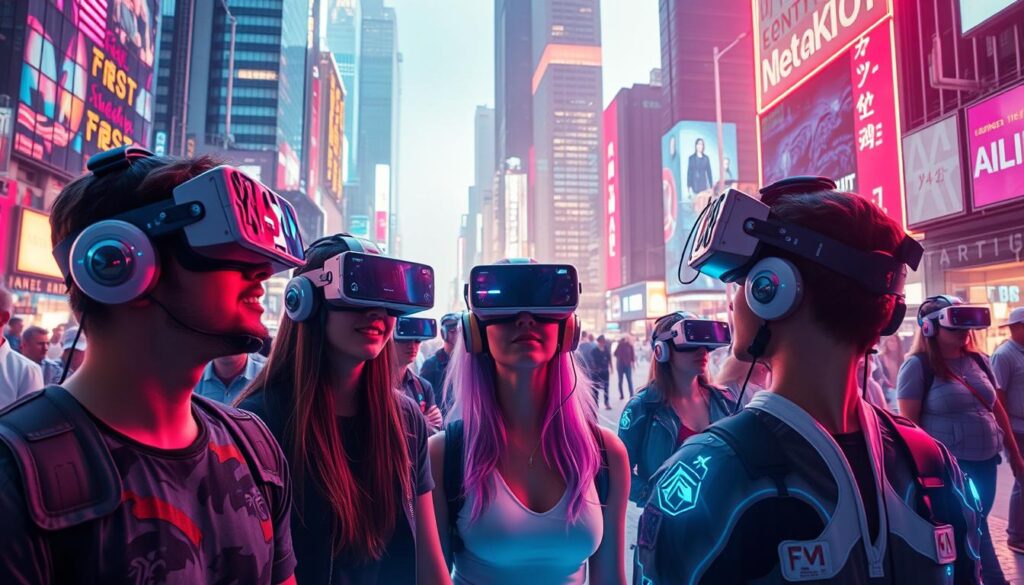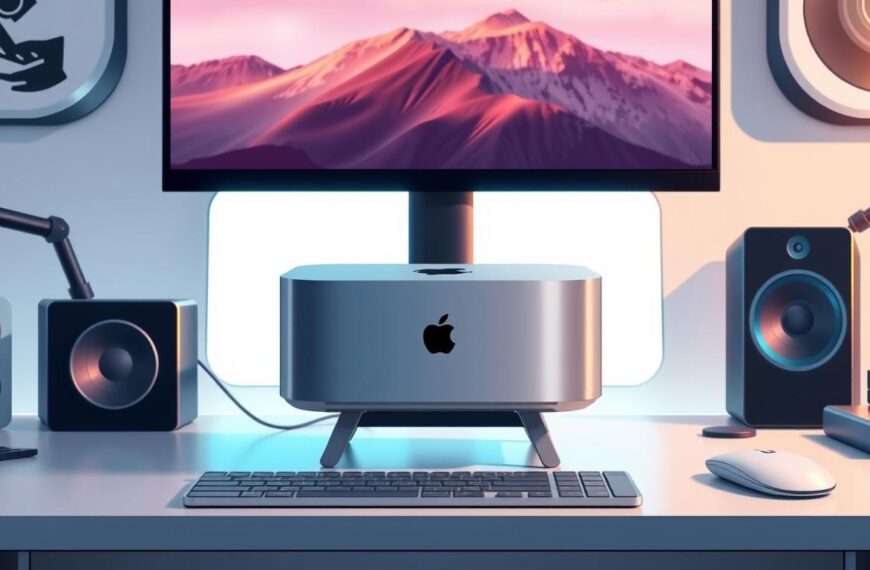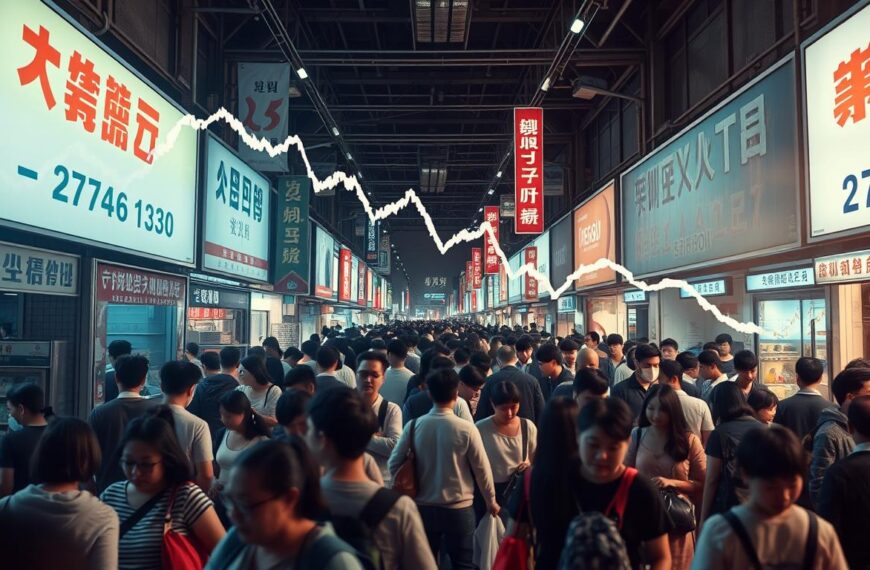“The future is already here – it’s just not very evenly distributed.” – William Gibson, a famous cyberpunk author, sums up the metaverse’s arrival. Tech giants like Meta, Microsoft, and Apple are spending billions to build immersive digital worlds. They’re racing to shape the next big thing in computing.
The metaverse blends the real and digital worlds. It’s a place where people, using their own avatars, can interact, work, play, and even buy things. This idea of a single, lasting virtual world excites tech leaders, investors, and the public.
Key Takeaways
- The metaverse is a mix of virtual and real worlds, where users connect through avatars in 3D spaces.
- Big tech companies like Meta, Microsoft, and Apple are investing heavily in metaverse platforms and tools.
- The metaverse offers new chances for deep experiences, digital economies, and the use of new tech like blockchain and cryptocurrencies.
- There are hurdles like tech limits, privacy worries, and the need for common standards to make the metaverse a reality.
- The future of the metaverse will depend on how innovation, rules, and social effects work together.
The Rise of the Metaverse
The metaverse is a mix of digital and physical worlds. It’s becoming more popular as virtual reality and augmented reality get easier to use. These technologies are changing how we connect, work, and have fun in 3D environments and digital worlds.
Virtual and Augmented Reality: Gateways to the Metaverse
VR and AR are growing fast, with a 30% yearly increase. This shows more people want immersive experiences. These technologies help us move easily between the real and virtual worlds.
Metaverse: A Convergence of Digital and Physical Worlds
The metaverse combines digital and physical spaces. It offers new chances for socializing, fun, shopping, and working together from afar. Online games and virtual worlds like Second Life, Habbo Hotel, and Minecraft are early examples. They mix social media and lasting virtual places.
“The metaverse could become as significant as the internet itself,” – Microsoft CEO
The metaverse is changing how we see and interact with digital spaces. It’s making the line between real and virtual less clear.
Key Players in the Metaverse Race
In the fast-changing world of the metaverse, big names like Meta (formerly Facebook) and Microsoft are leading the way. They are using their vision to guide the metaverse into the future. This digital world is set to change how we interact and play.
Meta’s Vision: Building the Metaverse
Meta is fully committed to making the metaverse a reality. They want it to be a place where people can meet, work, and have fun. Their project, Facebook Horizon, uses VR and AR to create a virtual world.
With over 3.6 billion users, Meta is ready to bring its audience into this new world.
Microsoft’s Spatial Computing Approach
Microsoft is also making big moves in the metaverse. They’ve added virtual avatars and meetings to Microsoft Teams. Their focus on “spatial computing” makes them a key player in the metaverse’s development.
Microsoft’s recent buy of Activision Blizzard will help them bring games and entertainment into the metaverse.
Other big names like Nvidia, Unity, Roblox, and Snap are also working on the metaverse. The race to lead in the metaverse is intense. The winners will change how we live, work, and play online.
Metaverse Platforms and Virtual Worlds
The metaverse is growing fast, with online games and virtual worlds leading the way. Fortnite, Roblox, and VRChat are key players, offering 3D environments for users to explore. They show the metaverse’s potential, from games to social spaces.
Fortnite mixes gaming with social features, making it a metaverse pioneer. Roblox lets users create and share virtual worlds. VRChat is all about immersive chats and experiences in different 3D spaces.
These platforms are stepping stones to the metaverse’s full vision. They help test and improve virtual worlds. As the metaverse grows, these platforms will shape our digital future.
| Platform | Key Features | User Base |
|---|---|---|
| Fortnite | Integrated metaverse-like features, blending gaming and social experiences | Over 350 million registered users |
| Roblox | User-generated content platform, enabling players to create and explore virtual worlds | Over 200 million monthly active users |
| VRChat | Social VR platform, allowing users to engage in immersive conversations and experiences | Over 30,000 daily active users |
As the metaverse evolves, these platforms will be key in shaping our digital future.
The Metaverse Economy: Virtual Assets and NFTs
The metaverse is changing the digital economy. Virtual assets and NFTs are key to this change. They let users own, trade, and make money from unique virtual items.
NFTs started in 2017 with CryptoPunks and CryptoKitties. These projects showed blockchain’s power in digital assets. Now, OpenSea is the biggest NFT marketplace, where people buy and sell digital items and art.
Blockchain and Cryptocurrencies in the Metaverse
Blockchain and cryptocurrencies are essential for the metaverse economy. They make virtual assets move and work together across different places. People use Ethereum, Bitcoin, or Binance Coin to buy NFTs from creators or on platforms like Rarible and OpenSea.
NFTs are changing how we own and make money in the metaverse. For example, virtual land in Decentraland and Somnium Space, in-game items in Axie Infinity, and digital art on Rarible and SuperRare are all growing. They show the power of the metaverse’s digital economy.
The metaverse is growing, and so is the role of virtual assets, NFTs, blockchain, and cryptocurrencies. They are making new ways for users to interact, create, and trade in the digital world.
Applications of the Metaverse
The metaverse is changing many parts of our lives. It’s affecting gaming, entertainment, social interaction, and immersive experiences. This virtual world is growing fast, bringing together the digital and physical.
Immersive Experiences: Gaming, Entertainment, and Social Interaction
The metaverse is making immersive experiences possible. The gaming world is already seeing big changes. It’s expected to grow to over $660 billion by the end of the decade.
Now, gamers can explore new virtual worlds. They can interact with others and join in on activities like never before.
The metaverse is also changing entertainment. We’re seeing virtual concerts and interactive learning spaces. Even companies like Animoca Brands and Planet Hollywood are working together in The Sandbox.
The metaverse is also great for social interaction. Places like IMVU let users create 3D avatars. This way, people can connect and share experiences, no matter where they are.
| Application | Example |
|---|---|
| Gaming | The global metaverse gaming market is projected to exceed $660 billion by the end of the decade. |
| Entertainment | Animoca Brands, in collaboration with Planet Hollywood, is establishing a studio backlot within The Sandbox, a metaverse platform, to enhance filming sets virtually. |
| Social Interaction | IMVU, an online social network game launched in 2004 where users generate 3D avatars, has gained significant popularity. |
The metaverse is growing fast. It’s set to bring us many immersive experiences. These will change how we interact, entertain, and work together online.
Technological Challenges and Limitations
The metaverse is growing, but it faces many tech challenges. One big issue is the state of VR and AR hardware, like VR headsets. These devices are still pricey, heavy, hard to move, and don’t show things clearly. This makes it hard for more people to use them comfortably.
Another big problem is that different metaverse platforms don’t work well together. This makes it tough to move virtual items and experiences easily. To fix this, groups are working on setting standards like Universal Scene Description (USD) and glTF. These standards aim to make the metaverse more connected and user-friendly.
Hardware Constraints and Advancements
The growth of the metaverse depends a lot on VR and AR tech. Today’s headsets and devices are still expensive, heavy, and don’t show things well. But, tech companies are working hard to make things better. They want to make the metaverse more welcoming and easy to use.
Interoperability and Standardization
The idea of the metaverse is a connected, working-together virtual world. But, the lack of common rules is a big problem. Without shared standards, moving virtual items and experiences is hard. To solve this, efforts are underway to create industry-wide standards. This includes USD and glTF, which are key to a smoother, more connected metaverse.
“Metaverse is the next generation of interaction, the Web 3.0 if you want to call it,” according to Alex Dzyuba, Lucid Reality Labs Founder & CEO.
Privacy, Security, and User Safety Concerns
The metaverse is growing, but so are worries about privacy, security, and safety. People are concerned about how their personal info and biometric data are used. This is especially true for targeted ads and potential misuse.
There’s a big gap in metaverse regulations. Over 60% of users worry about their data and privacy. Companies entering this space need to think about privacy to avoid damaging their reputation.
Data Privacy and Targeted Advertising
Privacy issues in the metaverse include no regulations, lots of data collection, and unclear data ownership. Businesses can help by being open about what data they collect and how it’s used. They should also use blockchain to manage digital assets and follow data privacy laws.
The future of privacy in the metaverse will depend on businesses leading the way. They need to create clear privacy guidelines and work with platform owners. Blockchain and privacy technologies are becoming more common, helping users own their digital assets.
Many users, 45%, want to stay anonymous in the metaverse. But, there’s a 25% rise in concerns about digital asset security. The metaverse also brings new risks like harassment and abuse, which need strong moderation.
Societal Implications of the Metaverse
The metaverse is changing how we live and interact. It could make online echo chambers worse and lead to digital alienation. There’s also worry it might become an escape from reality, causing addiction and mental health issues.
Ethical Considerations and Potential Risks
The metaverse raises many ethical questions. Investment bank Jeffries sees it as a major change in our lives. It could risk our privacy and security, just like the internet. Scams using stolen data, like voices, are becoming more common, with 5,100 cases in the U.S. in 2022.
The metaverse’s immersive nature might increase surveillance capitalism. This means more personal data could be used for profit. This could make it hard for regulators to protect our privacy and security. It also raises questions about corporate power and its impact on our choices.
The metaverse could also affect workers’ mental health. Companies might use personal data in ways that harm workers. This raises concerns about data breaches and how users are engaged.
“The metaverse necessitates a significant amount of personal information to create personalized and immersive user experiences.”
Dealing with these challenges is key as the metaverse grows. We need policymakers, tech companies, and the public to work together. They must focus on protecting user privacy, security, and well-being.
Regulatory Framework and Governance
The metaverse is growing, and so are calls for a strong regulatory framework. Policymakers and industry leaders are figuring out how to manage this virtual world. They aim to balance innovation with protecting users.
Big tech companies like Meta, Amazon, Google, and Microsoft are leading the way in the metaverse. Different platforms have different governance systems. Some are controlled by developers, while others use democratic models. This shows the need for clear rules and standards.
There are worries about crimes in the metaverse, like identity theft and fraud. The trading of illegal items is also a concern. Using biometric data for ads has raised privacy concerns.
The European Union is tackling these issues. The GDPR and the Digital Services Act aim to improve online safety. They want to make platforms accountable and transparent. But, protecting biometric data in the metaverse is still a big challenge.
As the metaverse evolves, we need a solid regulatory framework. This includes setting industry standards and implementing Know Your Customer (KYC) rules. We must also create safe spaces for mental health and find ways to deal with bad actors.
Creating an independent body to oversee the metaverse could help. Integrating financial best practices, like publishing fees and using collateral, can also improve security and transparency.
Policymakers, industry leaders, and advocates must work together. They need to address regulatory and governance issues. This way, we can ensure the metaverse is developed responsibly, protecting users and their rights.
The Future of Metaverse Headsets
The future of the metaverse depends on better virtual and augmented reality hardware. Companies are working to fix issues like cost, weight, and visual quality in metaverse headsets, VR headsets, and AR headsets. They aim to make devices more accessible and immersive.
Hardware advancements like lightweight tech, haptic feedback, and faster processing are key. These will lead to the next big leap in metaverse hardware. This will make the metaverse more accessible and enjoyable for everyone.
A recent survey shows the VR headset market could hit $45.09 billion by 2026. It’s growing at 31.5% each year. This growth is due to VR’s increasing use in gaming, entertainment, education, and healthcare.
The AR market is also booming. It was worth $15.3 billion in 2020 and could reach $463.7 billion by 2027. This is a 43.8% annual growth rate. AR is becoming more popular in advertising, remote work, education, and training.
Experts say the Metaverse will be a major part of our lives by 2030. It will be used for socializing, work, entertainment, and shopping. The key to this will be VR and AR technologies. Better metaverse headsets will be essential for this vision.
“78% of consumers believe that VR and AR technologies will play a significant role in shaping the future of digital experiences.”
As the metaverse grows, we’ll see more innovation in metaverse headsets, VR headsets, and AR headsets. These improvements will open up new ways to experience the digital world. They will change how we interact, work, and have fun online.
Conclusion
The metaverse is changing how we use technology and connect with each other online. It’s still growing and has many challenges. But, big tech companies and startups are investing a lot, showing it will shape our future.
As the metaverse grows, we need to tackle big issues like how it affects society and the rules around it. The fast growth of the metaverse market shows it has a bright future. This is thanks to advances in virtual and augmented reality, and blockchain.
But, the metaverse also has risks like money laundering, privacy issues, and how it might affect society. We must create strong rules and think about ethics to make the metaverse safe and fair for everyone.
















